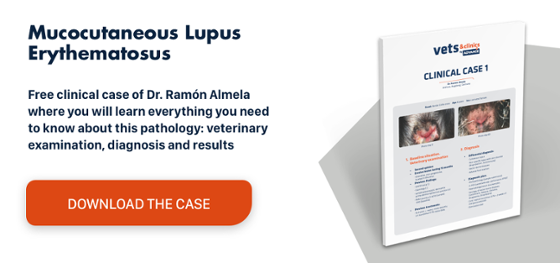Cutaneous leishmaniasis in dogs
Leishmaniasis in dogs is a serious parasitic disease caused by parasitic protozoa of the genus Leishmania, especially Leishmania infantum. It is transmitted to dogs through mosquito bites. Mosquitoes become Leishmania carriers having previously bitten other dogs with leishmaniasis.
What is leishmaniasis?
Leishmaniasis is a very serious disease caused by parasitic protozoa of the genus Leishmania, particularly Leishmania infantum, which are transmitted through the bites of mosquitoes that have already bitten an infected dog.
The mosquitoes that transmit Leishmania belong to the genera Phlebotomus (in Mediterranean and tropical regions) and Lutzomyia (tropical and subtropical regions).
In Spain, leishmaniasis in dogs is mainly concentrated in the Mediterranean basin and its peak period spans from late spring to late autumn. It affects all breeds.
Clinical signs of leishmaniasis in dogs
Some dogs with leishmaniasis may remain asymptomatic for varying durations depending on their immune system. Others present a highly variable clinical picture because the disease affects a wide range of organs and systems.
Depending on the mechanism of damage there are two clinical patterns:
- In areas where the parasite multiplies: localised nonsuppurative granulomatous inflammation. Given this mechanism, it courses with chronic hepatitis, dermatitis and chronic interstitial nephritis.
- Different anatomical locations: due to immune complex deposition. This second mechanism causes vasculitis, uveitis, glomerulonephritis and arthritis.
Cutaneous leishmaniasis in dogs
Consequently, there are two types of leishmaniasis in dogs: visceral and cutaneous. Cutaneous leishmaniasis is the most prevalent, with dermatological signs developing in up to 80% of cases.
The most common clinical signs are:
- Alopecia: a thin layer of dry, dull, brittle hair. Hair loss occurs on the ears and around the eyes.
- Ulcerative dermatitis, nodular dermatitis, pustular dermatitis or nodules, and ulcerations on mucous membranes. Intradermal nodules or ulcers usually develop on the surface of the skin.
- Hyperkeratosis: the main finding is excessive epidermal scaling with thickening, depigmentation (loss of skin colour) and cracks on the muzzle and paw pads.
- Abnormally long or brittle claws.
- Generalised adenomegaly, particularly marked around the popliteal and axillary nodes, if the limbs are affected.
- The vasculitis caused by the parasite visibly manifests as ear-tip necrosis.
Leishmaniasis in dogs: prevention
The ease with which it spreads and its potentially lethal consequences means prevention is the most effective weapon.
This is mainly based on two aspects, avoiding the risk of insect bites.
Leishmaniasis in dogs: treatment
Pharmacological treatment and a suitable diet can allow dogs with leishmaniasis to live asymptomatically for a long time.
Treatments include pentavalent antimonials and other drugs, such as amphotericin B, pentamidine and ketoconazole. They can be effective for several weeks and are given by injection or orally.
It has been noted that the animal’s progress can be improved by complementing the drug treatment for leishmaniasis with a diet adapted to the dog’s needs. Click here for guidance on the correct type of diet.
Thereforw, we recommend specific ally formulated diets, such as Advance Veterinary Diets Urinary Low Purine.
If there is kidney compromise, we recommend a renal diet.


